We flew into Darwin to explore the Northern Territory, Australia’s Top End. It’s HOT country, with humidity exacerbating high temperatures. And it’s rugged country, too. We had rented a 4WD vehicle at the airport, yet the guy at the counter admonished us not to take it on any non-paved or 4WD-only roads. What’s the use of renting 4WD if you can’t take it off-road?
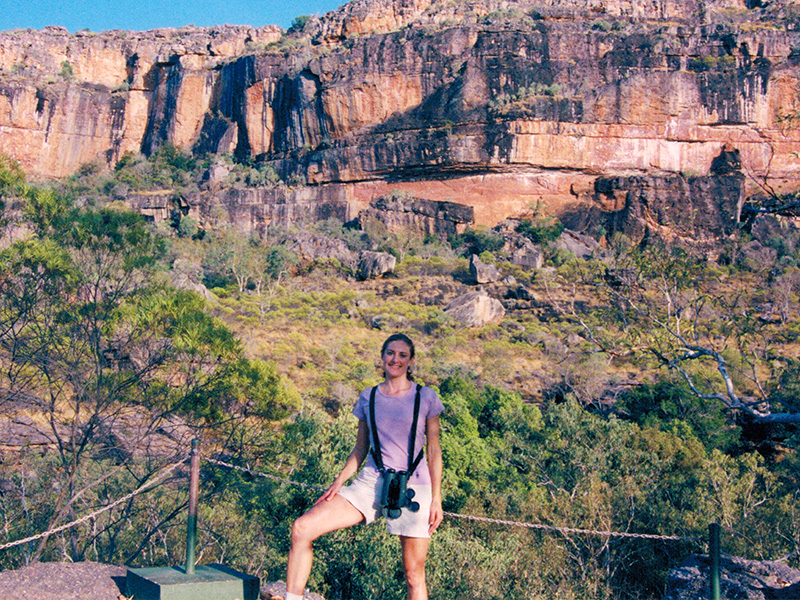 The Arnhem Highway to Kakadu National Park was paved, so we had no problem as we drove the 250 km to get to the Kakadu Lodge in the small town of Jabiru the next morning. On the way we stopped off at a number of birding hotspots and saw several new species, then continued on through dry country dotted with pandanus (also known as screw palm for the twisting way the fronds grow from the trunks), paperbark and scads of impossibly skinny trees. Ridged and pockmarked termite mounds even bigger than the ones we had come across in Queensland dotted the landscape here and resembled 10-foot-tall morel mushrooms.
The Arnhem Highway to Kakadu National Park was paved, so we had no problem as we drove the 250 km to get to the Kakadu Lodge in the small town of Jabiru the next morning. On the way we stopped off at a number of birding hotspots and saw several new species, then continued on through dry country dotted with pandanus (also known as screw palm for the twisting way the fronds grow from the trunks), paperbark and scads of impossibly skinny trees. Ridged and pockmarked termite mounds even bigger than the ones we had come across in Queensland dotted the landscape here and resembled 10-foot-tall morel mushrooms.
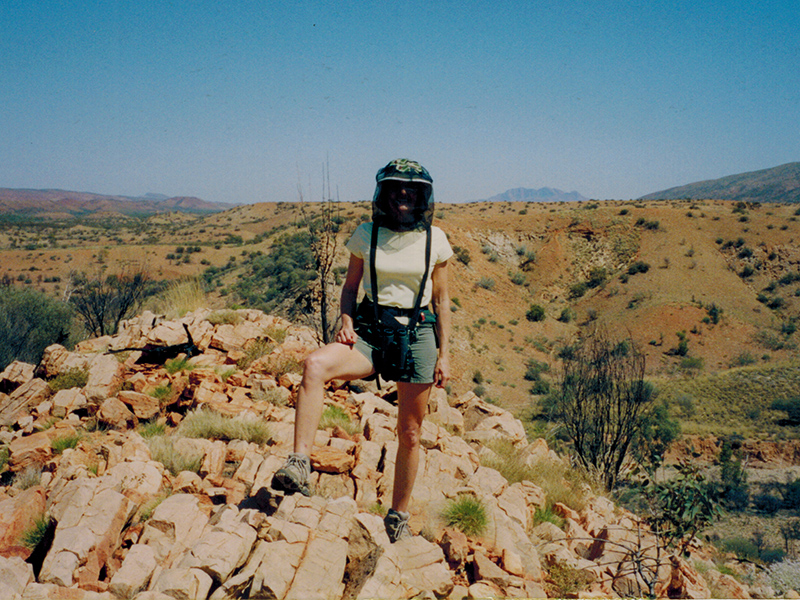 As we neared the park were dismayed to find the air heavy with smoke from all the fires intentionally set to keep the brush under control. Another vexing aspect of Kakadu: the flies that swarm your eyes, nose and mouth relentlessly, enough to drive the most sane person straight to the booby hatch. Head nets are essential.
As we neared the park were dismayed to find the air heavy with smoke from all the fires intentionally set to keep the brush under control. Another vexing aspect of Kakadu: the flies that swarm your eyes, nose and mouth relentlessly, enough to drive the most sane person straight to the booby hatch. Head nets are essential.
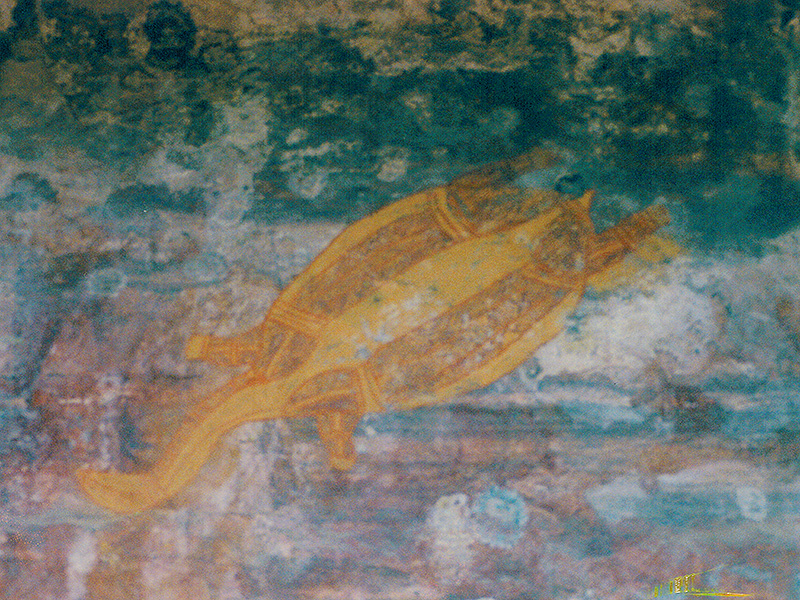 In addition to the bird life, marsupials and goannas — komodo dragon-like reptiles — that abound in Kakadu, the park is also famous for ancient rock art carved into stone escarpments. For visitors interested in ancient rock art, Kakadu has numerous noteworthy sites, including Ubirr and Nourlangie Rock, with some of the art dating back 20,000 years (but also, as noted in the park brochure, some as recent as 1985).
In addition to the bird life, marsupials and goannas — komodo dragon-like reptiles — that abound in Kakadu, the park is also famous for ancient rock art carved into stone escarpments. For visitors interested in ancient rock art, Kakadu has numerous noteworthy sites, including Ubirr and Nourlangie Rock, with some of the art dating back 20,000 years (but also, as noted in the park brochure, some as recent as 1985).
One evening there was a slide show and lecture at the next lodge over on local wildlife and I thought, “Oh, goody, I love lectures! I might learn something new.” Fat chance! The presenter was three sheets to the wind, holding a can of beer in one hand and a cigarette in the other. At each slide he would make remarks like “this particular species is good tucker (fine eating),” or “I’ve forgotten that one’s name,” or “I’m not going to tell you about this because you can find that out for yourself.” That was, of course, when he advanced the slides forward instead of back to what we’d just seen, mumbling curses and tottering on his heels each time. I thought the presentation would never end, but no one else in the audience batted an eyelash.
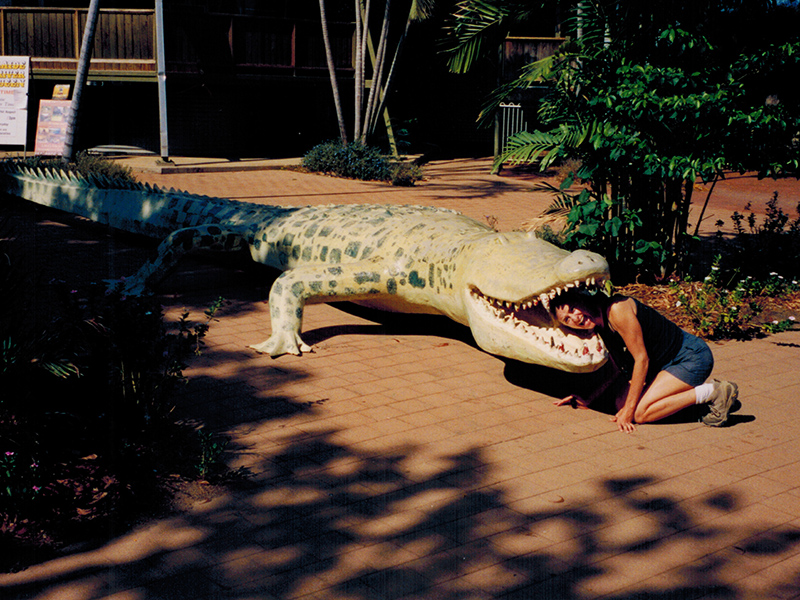 One characteristic in the Top End, at least according to Aussies from other parts of the country, is the renegade spirit. It’s not surprising that rough-and-tumble country like this produces rule-bending eccentrics. One man we met at a lodge told us about a former guest who had his name legally changed to Caveman (no last name). Apparently it was a fitting moniker because he was a rather hairy fellow missing some teeth who roamed around finding food and shelter where he could. We also heard about another Top Ender who legally changed his name to Lunar Eclipse.
One characteristic in the Top End, at least according to Aussies from other parts of the country, is the renegade spirit. It’s not surprising that rough-and-tumble country like this produces rule-bending eccentrics. One man we met at a lodge told us about a former guest who had his name legally changed to Caveman (no last name). Apparently it was a fitting moniker because he was a rather hairy fellow missing some teeth who roamed around finding food and shelter where he could. We also heard about another Top Ender who legally changed his name to Lunar Eclipse.
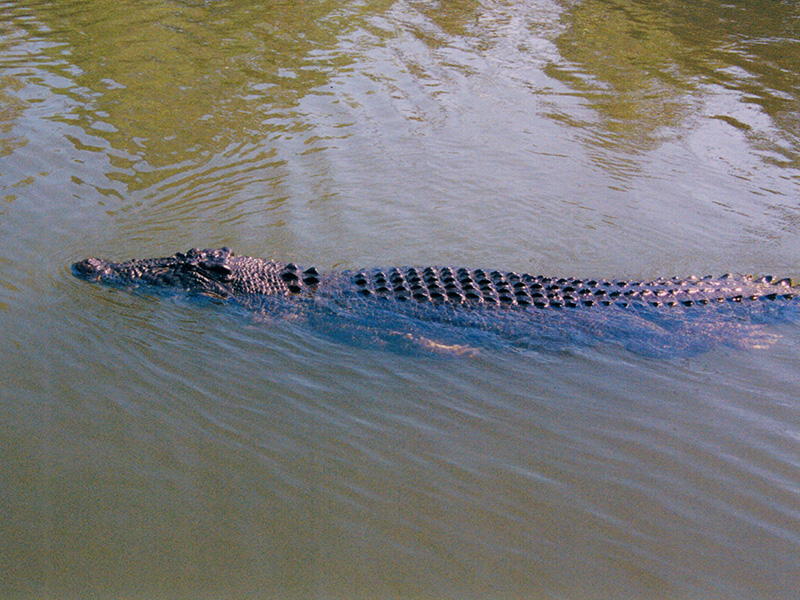 We took a boat trip in the Yellow Water area of Kakadu with a captain who knew his birds and was an excellent spotter. We saw a few saltwater crocodiles, two new kingfisher species, the brolga (a kind of crane that’s very tall and very shy), a buff-banded rail and many other water birds. Out on the water, mercifully, the flies seemed to dissipate a bit.
We took a boat trip in the Yellow Water area of Kakadu with a captain who knew his birds and was an excellent spotter. We saw a few saltwater crocodiles, two new kingfisher species, the brolga (a kind of crane that’s very tall and very shy), a buff-banded rail and many other water birds. Out on the water, mercifully, the flies seemed to dissipate a bit.
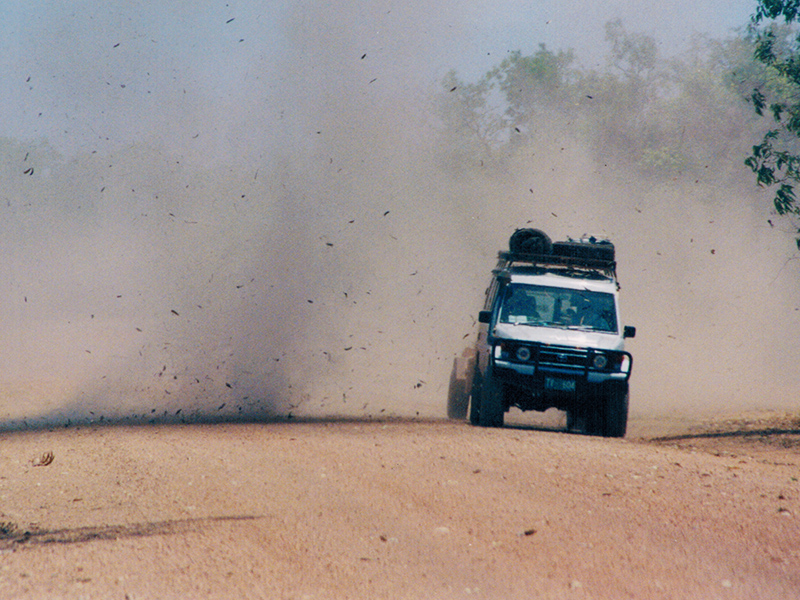 The next day we drove back west to our next destination, Mary River National Park, via Old Jim Jim Road. This was one of those 4WD-only tracks the rental car agent warned about, but we figured we’d see more wildlife off the beaten path. Maybe the rule-bending attitude up here had rubbed off on us. This being September during the dry season, for the most part the road was a dusty washboard, and the single river crossing proved shallow enough for the vehicle. Every so often we would spot a bird, hit the brakes and come skidding to a halt in a cloud of dust, but by the time the air cleared the bird would be gone.
The next day we drove back west to our next destination, Mary River National Park, via Old Jim Jim Road. This was one of those 4WD-only tracks the rental car agent warned about, but we figured we’d see more wildlife off the beaten path. Maybe the rule-bending attitude up here had rubbed off on us. This being September during the dry season, for the most part the road was a dusty washboard, and the single river crossing proved shallow enough for the vehicle. Every so often we would spot a bird, hit the brakes and come skidding to a halt in a cloud of dust, but by the time the air cleared the bird would be gone.
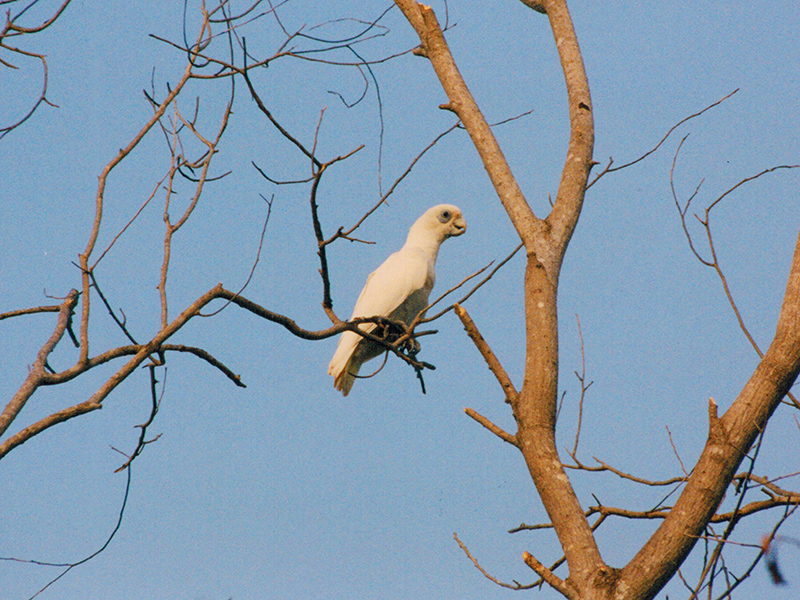 The Mary River Wilderness Retreat just outside the park was a hot, noisy, fly-ridden dump, at least back in 2005 during my visit (from the looks of the website, though, it seems they’ve spruced the place up a bit since then). The trees on the grounds were full of little corellas, an all-white member of the cockatoo family that at first I found quite charming, but I soon realized that I wouldn’t get a moment’s peace with them screeching incessantly overhead. The “bungalow” we booked was a spare, 6×12-foot portable tin trailer with the bathroom outside. Bugs crawled over me in bed at night. Perhaps swatting at tiny moving creatures on my face had become a reflex at that point. However, the little hovel did have the one key requirement for this kind of environment: air conditioning. We also had a great bowerbird hanging about in a bush right outside the bungalow.
The Mary River Wilderness Retreat just outside the park was a hot, noisy, fly-ridden dump, at least back in 2005 during my visit (from the looks of the website, though, it seems they’ve spruced the place up a bit since then). The trees on the grounds were full of little corellas, an all-white member of the cockatoo family that at first I found quite charming, but I soon realized that I wouldn’t get a moment’s peace with them screeching incessantly overhead. The “bungalow” we booked was a spare, 6×12-foot portable tin trailer with the bathroom outside. Bugs crawled over me in bed at night. Perhaps swatting at tiny moving creatures on my face had become a reflex at that point. However, the little hovel did have the one key requirement for this kind of environment: air conditioning. We also had a great bowerbird hanging about in a bush right outside the bungalow.
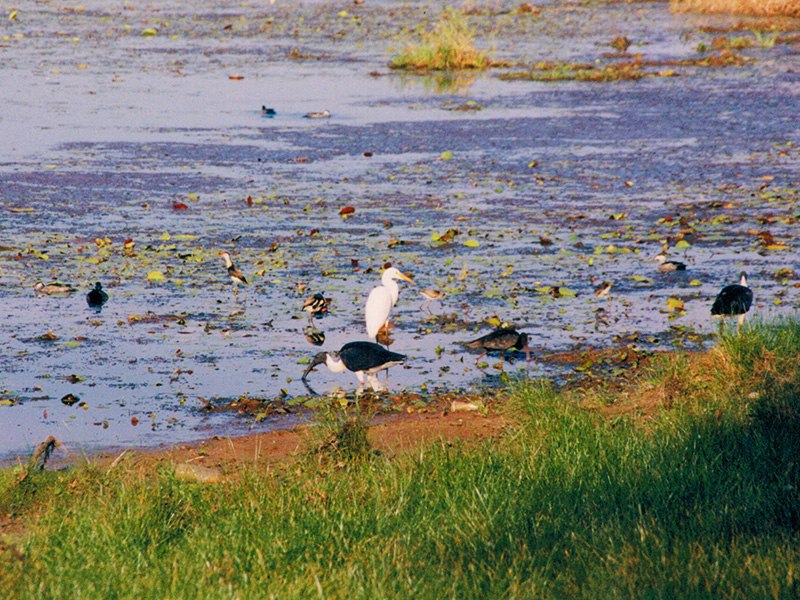 Later that afternoon when it cooled down a bit, we traveled with a park guide to some of the few remaining wet billabongs (ponds). Billabongs can be some of the best places to see birds and wildlife that congregate to sip the little bit of water left at the tail end of the dry season. We found more saltwater crocodiles, wallabies and various birds, and it was good to get away from the corellas back at the lodge.
Later that afternoon when it cooled down a bit, we traveled with a park guide to some of the few remaining wet billabongs (ponds). Billabongs can be some of the best places to see birds and wildlife that congregate to sip the little bit of water left at the tail end of the dry season. We found more saltwater crocodiles, wallabies and various birds, and it was good to get away from the corellas back at the lodge.
One of the other lodge guests told us about a flock of Gouldian finches that had been coming to a tiny water hole not too far away, and he agreed to take us there early the next morning. Gouldian finches are the little yellow, purple and green birds with black or red faces that decorated the old ViewSonic computer monitors years ago. We arrived just after sunrise and waited for the flock to arrive. Arrive they did, in all their colorful glory. Several other species of tiny finches arrived as well, making it a richly rewarding finch frenzy. Unfortunately, we couldn’t get decent photos of the tiny birds.
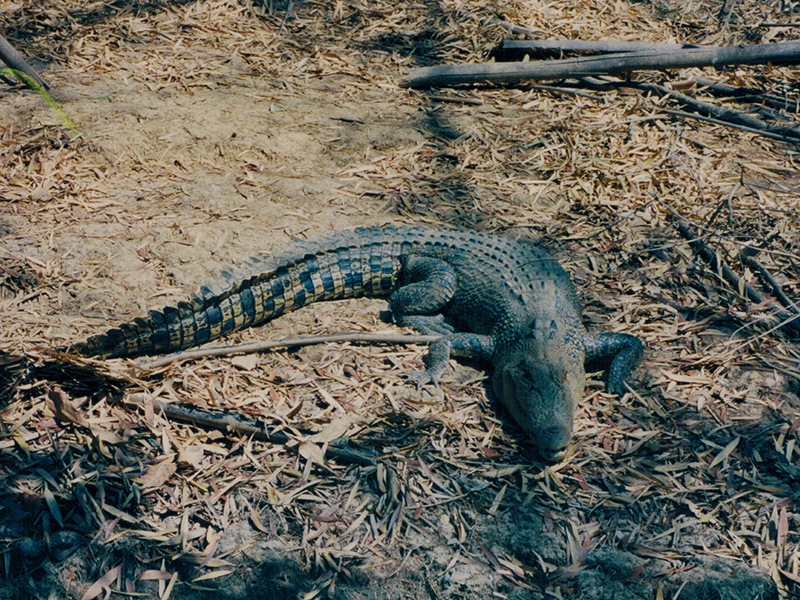 Later that morning we took a boat ride on the nearby Mary River and found both saltwater and freshwater crocodiles as well as numerous kingfishers and other water birds. The breeze on the water gave us a reprieve from the flies before we had to return and spend the rest of the day hunkered down in our little hovel or in the swimming pool. We decided to head out on a late afternoon drive to some additional billabongs and were glad we did. Several galahs — delightful pink and gray cockatoos — flocked high in a tree for just a few moments before heading off into the sunset.
Later that morning we took a boat ride on the nearby Mary River and found both saltwater and freshwater crocodiles as well as numerous kingfishers and other water birds. The breeze on the water gave us a reprieve from the flies before we had to return and spend the rest of the day hunkered down in our little hovel or in the swimming pool. We decided to head out on a late afternoon drive to some additional billabongs and were glad we did. Several galahs — delightful pink and gray cockatoos — flocked high in a tree for just a few moments before heading off into the sunset.
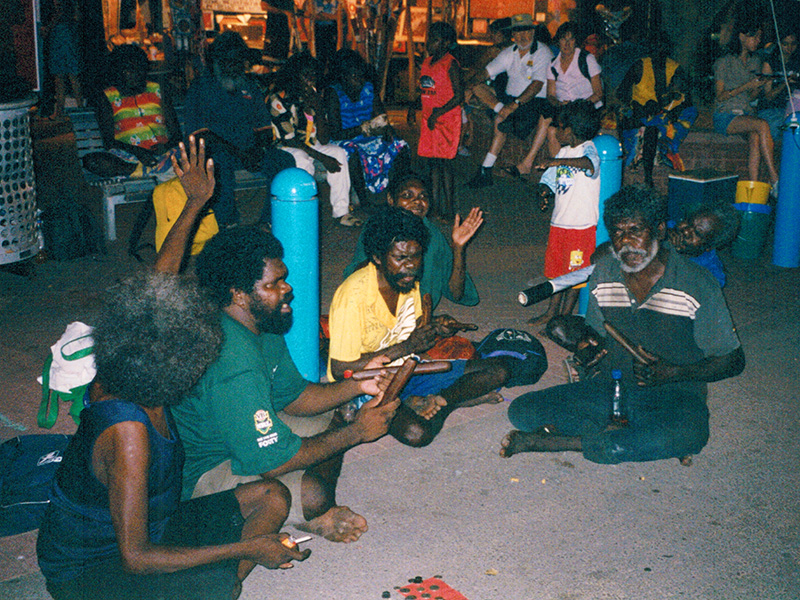 We returned to Darwin the next day and stopped off at Howard Springs Nature Park to search for the rare rainbow pitta, another of this country’s colorful birds. Alas, we heard a few calling but were unable to get a view of them. As a consolation prize, Darwin’s colorful Mindil Beach night market was a great place to grab some grub. Dozens of booths featured international and local foods such as Singapore noodles, crocodile satays, possum sausages and more Asian dishes than you can shake a chopstick at. A group of Aborigine chanters and drummers entertained the crowd for spare change. A visit to the night market was a nice way to top off our brief tour of the Top End.
We returned to Darwin the next day and stopped off at Howard Springs Nature Park to search for the rare rainbow pitta, another of this country’s colorful birds. Alas, we heard a few calling but were unable to get a view of them. As a consolation prize, Darwin’s colorful Mindil Beach night market was a great place to grab some grub. Dozens of booths featured international and local foods such as Singapore noodles, crocodile satays, possum sausages and more Asian dishes than you can shake a chopstick at. A group of Aborigine chanters and drummers entertained the crowd for spare change. A visit to the night market was a nice way to top off our brief tour of the Top End.
Up next: the Red Centre
“Shoo fly don’t bother me”! The head nets were a good thing to have, as you discovered.
In so many places, head nets are a sanity saver for sure.